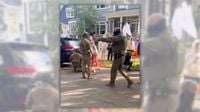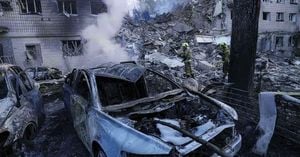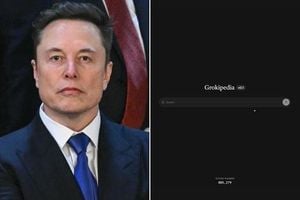Halloween in Chicago is usually a time for costumes, candy, and laughter echoing through neighborhood streets. But in 2025, the city’s cherished autumn ritual was jolted by a series of federal immigration enforcement actions that left families, children, and entire communities shaken. According to The New York Times and corroborated by local reports, federal agents deployed tear gas, chased suspects through front yards, and made several arrests across Chicago and its North Shore suburbs, including Evanston and Albany Park, during the days surrounding Halloween.
The first major incident unfolded on October 25 in Old Irving Park, a typically quiet neighborhood on Chicago’s Northwest Side, just as families were preparing for the annual Halloween parade. The Old Irving Park Association, a volunteer-led community group, had advertised a family-friendly parade and party to begin at 10:15 a.m. But minutes before the festivities were set to start, Border Patrol agents—operating under Customs and Border Protection (CBP), not ICE—released tear gas in the neighborhood. Multiple witnesses, court documents, and videos confirmed the deployment, which led to the parade’s abrupt cancellation or relocation. The incident left children in costumes and their parents visibly upset, some in tears, as their much-anticipated celebration was upended.
James Hotchkiss, a local resident, captured the mood in court testimony: “I was really scared. I have two young kids. We were about to walk out of the house to go to a Halloween parade that was supposed to start 15 minutes later and walk down that street. My understanding is that the parade was canceled and activities stayed on the school grounds. My daughter was very upset for most of the morning.” (Snopes)
Eyewitnesses and local news outlets, including WFLD-TV, reported that agents began lobbing tear gas around 9:50 a.m., moments before children were set to march toward St. Viator’s, a local Catholic grammar school. Videos showed agents emerging from a vehicle that had struck a bicyclist, then deploying gas as bystanders shouted in protest. The Department of Homeland Security (DHS) later stated that agents had been “surrounded and boxed in by a group of agitators” while attempting to arrest a person described as a “criminal illegal alien from Mexico, who has previously been arrested for assault.” According to DHS spokeswoman Tricia McLaughlin, “Federal law enforcement issued multiple lawful commands and verbal warnings, all of which were ignored… To safely clear the area after multiple warnings and the crowd continuing to advance on them, Border Patrol had to deploy crowd control measures.”
The fallout was immediate. Illinois Governor JB Pritzker, a Democrat, urgently requested that Homeland Security Secretary Kristi Noem pause immigration raids during Halloween, citing the distress caused by the tear gas incident. “Illinois families deserve to spend Halloween weekend without fear,” Pritzker wrote in a letter to federal officials. “No child should be forced to inhale tear gas or other chemical agents while trick-or-treating in their own neighborhood.” Secretary Noem, however, declined the request, and enforcement operations continued as planned.
As Halloween approached, anxiety mounted across Chicago. Neighborhoods organized watch groups, with volunteers stationed on corners, whistles in hand, ready to alert neighbors if immigration agents appeared. The city braced itself for more confrontations, and unfortunately, those fears were realized on October 31—Halloween itself.
On that day, federal immigration agents fanned out across Chicago and its northern suburbs. In Evanston, a suburb just north of the city, tensions boiled over when a car rear-ended a Border Patrol vehicle. Videos shared with The New York Times showed agents tackling the driver, a woman, to the ground as bystanders yelled and blew whistles. Allie Harned, a social worker at nearby Chute Middle School, described the chaotic scene: “When I came upon her, they were tearing her out of the car. She was on the ground. Her shoes fell off.” Police responded as the crowd’s anger grew, and at least one bystander was detained. In one video, an officer briefly brandished a weapon at the crowd, further escalating the situation.
The incident occurred near both Chute Middle School and an elementary school, just hours before children were set to go trick-or-treating. Out of caution, the schools locked down, keeping students indoors for recess. At a press conference later that day, children peered out of open windows to watch local officials denounce the federal government’s actions. Evanston’s mayor, Daniel Biss, who is also running for Congress, spoke forcefully: “Just today, ICE agents have assaulted Evanston residents, beaten people up, grabbed them, abducted them, taken people off the street. It is an outrage.”
The Department of Homeland Security defended its agents, stating that the crowd had “began verbally abusing them and spitting on them.” DHS characterized the incident as part of a “growing and dangerous trend of violence and obstruction,” noting an increase in assaults and vehicle rammings targeting federal law enforcement during operations. “These confrontations highlight the dangers our agents face daily and the escalating aggression toward law enforcement,” the statement read.
Elsewhere in Chicago, similar scenes played out. In Albany Park, Border Patrol agents arrested at least two people who had physically confronted them, according to witnesses. Several individuals, including at least one U.S. citizen, were arrested for interfering with immigration operations. The overall effect was a city on edge, with families fearful that Halloween itself had become a target.
Behind the scenes, these events were playing out against the backdrop of President Donald Trump’s ongoing crackdown on illegal immigration in Chicago. Both CBP and ICE, under the umbrella of DHS, were involved in the operations. The aggressive tactics drew sharp criticism from local leaders and civil liberties advocates. In response to complaints that federal agents were violating the First Amendment rights of journalists and protesters, U.S. District Judge Sara Ellis issued a temporary restraining order largely prohibiting the use of tear gas and other riot control measures on journalists, protesters, and clergy.
Judge Ellis did not mince words when admonishing Gregory Bovino, the senior Border Patrol official leading the Chicago crackdown. During an October 28 court hearing, she pointedly referenced the Old Irving Park incident: “So kids dressed in Halloween costumes, walking to a parade, do not pose an immediate threat to the safety of a law enforcement officer or others. They just don’t. And you can’t use riot control weapons against them.” She continued, “These kids, you can imagine their sense of safety was shattered on Saturday. And it’s going to take a long time for that to come back, if ever. And not only was their sense of safety shattered, but it’s connected to something that should have been a really happy day.”
Despite the judge’s order, reports of forceful tactics continued. Judge Ellis required Bovino to appear in her courtroom each weeknight to answer questions about daily enforcement activities and agents’ compliance with restrictions. However, the federal government objected, and on November 1, an appellate court blocked the requirement for Bovino’s daily appearances.
In the aftermath, the Old Irving Park Association praised its parents’ committee for “pivoting last minute amidst fluid and challenging circumstances,” but the disruption was felt deeply. The association’s letter to neighbors expressed gratitude for the community’s resilience, even as families grappled with fear and uncertainty.
With the dust settling, one thing is clear: Halloween 2025 in Chicago will be remembered not for the joy of costumes and candy, but for the tension, fear, and controversy that swept through its neighborhoods. The scars—emotional and communal—may linger long after the last piece of candy is eaten.




